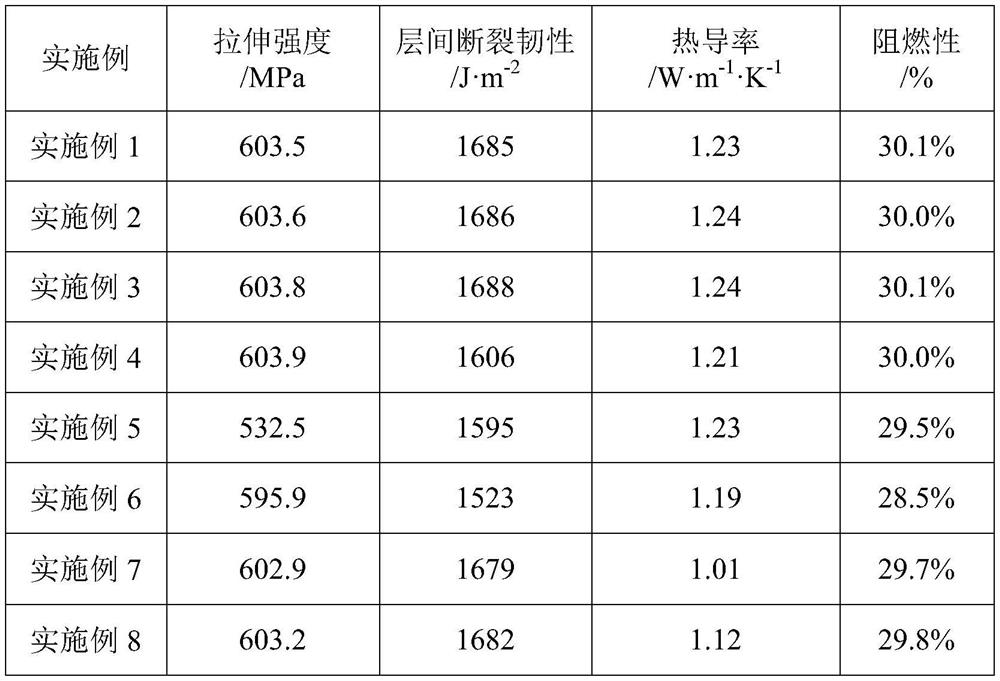Processing technology of epoxy glass fiber board
A technology of epoxy glass fiber and processing technology, which is applied in the direction of glass/slag layered products, synthetic resin layered products, chemical instruments and methods, etc. Oxygen glass fiber sheet thermal conductivity, poor interfacial compatibility and other issues, to achieve the effect of enhancing interfacial compatibility, increasing thermal conductivity, increasing elongation at break and tensile strength
- Summary
- Abstract
- Description
- Claims
- Application Information
AI Technical Summary
Problems solved by technology
Method used
Image
Examples
Embodiment 1
[0026]Step 1: Preparation of materials: (1) Preparation of silica sol: 12 parts of tetraethyl silicate, 8 parts of N-(2-aminoethyl)-3-aminopropyltriethoxysilane are added to Dissolve in a reaction kettle containing 35 parts of ethanol; add 1mol / L hydrochloric acid solution to adjust the pH of the reaction solution to 2; set the stirring speed at 150rmp, and the reaction temperature at 80°C for 10 hours, cool to obtain silica sol. (2) Preparation of mixed curing agent: A. under inert gas, diphenylazaborane is added in the reactor containing methylene chloride solution, stirred and dissolved; concentrated sulfuric acid and concentrated nitric acid are added dropwise, and reacted for 4 hours at room temperature; After the reaction, put it into an ice-water bath, extract it with ether, adjust the pH=7 with a saturated aqueous solution of sodium bicarbonate, wash, and dry to obtain dinitrophenazaborane; put it in a reaction kettle, and add Isopropanol, iron powder, concentrated sul...
Embodiment 2
[0032] Step 1: Preparation of materials: (1) Preparation of silica sol: 16 parts of tetraethyl silicate, 12 parts of N-(2-aminoethyl)-3-aminopropyltriethoxysilane are added to Dissolve in a reaction kettle containing 40 parts of ethanol; add 1mol / L hydrochloric acid solution to adjust the pH of the reaction solution to 3; set the stirring speed at 180rmp, and the reaction temperature at 85°C for 12 hours, cool to obtain silica sol. (2) Preparation of mixed curing agent: A. under inert gas, diphenylazaborane is added in the reactor containing methylene chloride solution, stirred and dissolved; concentrated sulfuric acid and concentrated nitric acid are added dropwise, and reacted for 5 hours at room temperature; After the reaction, put it into an ice-water bath, extract it with ether, adjust the pH=8 with a saturated aqueous solution of sodium bicarbonate, wash, and dry to obtain dinitrophenazaborane; put it in a reaction kettle, and add Isopropanol, iron powder, concentrated s...
Embodiment 3
[0038] Step 1: Preparation of materials: (1) Preparation of silica sol: 14 parts of tetraethyl silicate, 10 parts of N-(2-aminoethyl)-3-aminopropyl triethoxysilane are added to Dissolve in a reaction kettle containing 38 parts of ethanol; add 1mol / L hydrochloric acid solution to adjust the pH of the reaction solution to 2.5; set the stirring speed at 165rmp, and the reaction temperature at 82°C for 11 hours, cool to obtain silica sol. (2) Preparation of mixed curing agent: A. under inert gas, diphenylazaborane is added in the reaction kettle containing methylene chloride solution, stirred and dissolved; concentrated sulfuric acid and concentrated nitric acid are added dropwise, and reacted for 4.5 hours at room temperature; After the reaction, put it in an ice-water bath, extract it with ether, adjust the pH=7.5 with a saturated aqueous solution of sodium bicarbonate, wash, and dry to obtain dinitrophenylazaborane; put it in a reaction kettle, and add Isopropanol, iron powder,...
PUM
| Property | Measurement | Unit |
|---|---|---|
| particle diameter | aaaaa | aaaaa |
| tensile strength | aaaaa | aaaaa |
Abstract
Description
Claims
Application Information
 Login to View More
Login to View More - R&D
- Intellectual Property
- Life Sciences
- Materials
- Tech Scout
- Unparalleled Data Quality
- Higher Quality Content
- 60% Fewer Hallucinations
Browse by: Latest US Patents, China's latest patents, Technical Efficacy Thesaurus, Application Domain, Technology Topic, Popular Technical Reports.
© 2025 PatSnap. All rights reserved.Legal|Privacy policy|Modern Slavery Act Transparency Statement|Sitemap|About US| Contact US: help@patsnap.com

